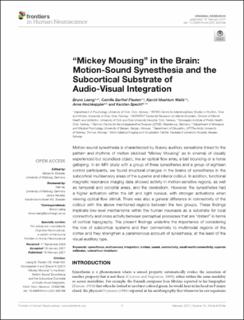| dc.contributor.author | Laeng, Bruno | |
| dc.contributor.author | Flaaten, Camilla Bärthel | |
| dc.contributor.author | Walle, Kjersti Mæhlum | |
| dc.contributor.author | Hochkeppler, Anne | |
| dc.contributor.author | Specht, Karsten | |
| dc.date.accessioned | 2021-07-07T09:55:35Z | |
| dc.date.available | 2021-07-07T09:55:35Z | |
| dc.date.created | 2021-02-15T10:05:03Z | |
| dc.date.issued | 2021-02-15 | |
| dc.identifier.issn | 1662-5161 | |
| dc.identifier.uri | https://hdl.handle.net/11250/2763707 | |
| dc.description.abstract | Motion-sound synesthesia is characterized by illusory auditory sensations linked to the pattern and rhythms of motion (dubbed “Mickey Mousing” as in cinema) of visually experienced but soundless object, like an optical flow array, a ball bouncing or a horse galloping. In an MRI study with a group of three synesthetes and a group of eighteen control participants, we found structural changes in the brains of synesthetes in the subcortical multisensory areas of the superior and inferior colliculi. In addition, functional magnetic resonance imaging data showed activity in motion-sensitive regions, as well as temporal and occipital areas, and the cerebellum. However, the synesthetes had a higher activation within the left and right cuneus, with stronger activations when viewing optical flow stimuli. There was also a general difference in connectivity of the colliculi with the above mentioned regions between the two groups. These findings implicate low-level mechanisms within the human neuroaxis as a substrate for local connectivity and cross activity between perceptual processes that are “distant” in terms of cortical topography. The present findings underline the importance of considering the role of subcortical systems and their connectivity to multimodal regions of the cortex and they strengthen a parsimonious account of synesthesia, at the least of the visual-auditory type. | en_US |
| dc.language.iso | eng | en_US |
| dc.publisher | Frontiers | en_US |
| dc.rights | Navngivelse 4.0 Internasjonal | * |
| dc.rights.uri | http://creativecommons.org/licenses/by/4.0/deed.no | * |
| dc.title | “Mickey Mousing” in the Brain: Motion-Sound Synesthesia and the Subcortical Substrate of Audio-Visual Integration | en_US |
| dc.type | Journal article | en_US |
| dc.type | Peer reviewed | en_US |
| dc.description.version | publishedVersion | en_US |
| dc.rights.holder | Copyright the authors | en_US |
| dc.source.articlenumber | 605166 | en_US |
| cristin.ispublished | true | |
| cristin.fulltext | original | |
| cristin.qualitycode | 1 | |
| dc.identifier.doi | https://doi.org/10.3389/fnhum.2021.605166 | |
| dc.identifier.cristin | 1889727 | |
| dc.source.journal | Frontiers in Human Neuroscience | en_US |
| dc.relation.project | Norges forskningsråd: 262762 | en_US |
| dc.relation.project | Norges forskningsråd: 217932 | en_US |
| dc.identifier.citation | Frontiers in Human Neuroscience. 2021, 15, 605166. | en_US |
| dc.source.volume | 15 | en_US |

